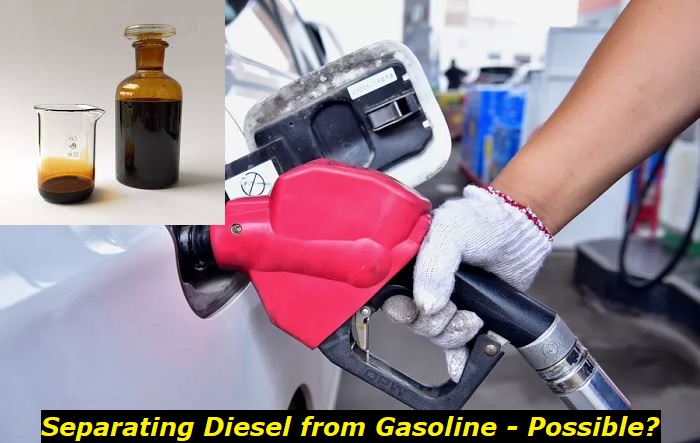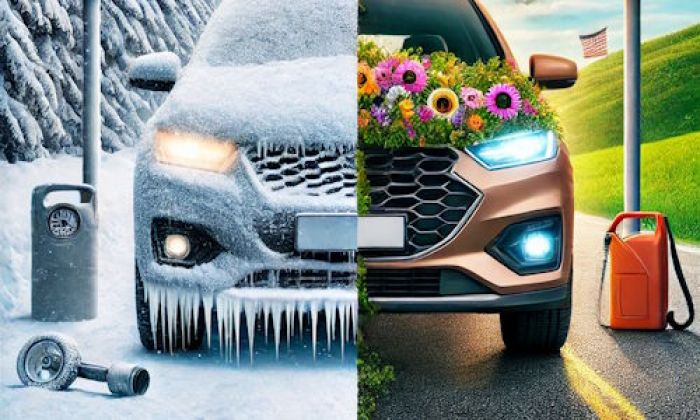Mistakes tend to happen especially when you're not at your best during the day. One of them is accidentally mixing diesel with gasoline during one of your regular trips on the gas pump. This can also occur if you own gasoline- and diesel-fed vehicles, and you absent-mindedly confuse one with the other when you are at a gas station.
Although the area in the fuel cap typically indicates whether your vehicle is powered by diesel or gasoline and the fuel nozzle differs for each type of fuel, there are still chances that you may unconsciously grab the wrong pump of the fuel dispenser, which may again result in the same scenario.
Regardless of the reason why you have mixed diesel with gasoline, we will discuss here if there's still a way to save your vehicle by separating the compound created by the mix, and see whether or not your fuel is still safe to use after that.

Diesel Vs Gasoline
Diesel and gasoline are two of the most common fuel sources used in transportation today. Although they may appear similar, they have many important differences that should be taken into account.
When it comes to color, diesel is generally a darker shade than gasoline, often appearing slightly brown. In terms of composition, diesel contains higher concentrations of carbon and hydrogen than gasoline does and is denser. This means that diesel has a higher energy density per unit volume than gasoline does, leading to increased fuel efficiency in vehicles powered by diesel engines.
For emissions, diesel engines produce significantly lower levels of volatile organic compounds (VOCs) than their gasoline counterparts. Additionally, burning diesel fuel releases fewer particulate matter emissions than burning gasoline, which can be harmful to the environment.
Moreover, diesel engines are typically more durable than gasoline engines and require less frequent maintenance. The higher compression ratio of diesel engines allows them to generate more torque at lower RPMs, making them a great choice for applications such as trucking or hauling heavy loads.
On the other hand, gasoline is characterized by its clearer emissions and better efficiency at higher RPMs. It has a lighter color than diesel, usually appearing as a light shade of yellow or orange.
Gasoline also has lower concentrations of carbon and hydrogen than diesel fuel, making it less energy-dense per unit volume. This means that gasoline engines typically generate more horsepower but with reduced fuel economy compared to diesel-powered vehicles.
Furthermore, gasoline engines require more frequent maintenance due to their lower compression ratio, although this varies depending on the manufacturer and type of engine used in your vehicle.
Separating Diesel from Gasoline
There are many threads and videos claiming that diesel can be separated from gasoline via flotation and filtration. Floatation is a process by which different types of molecules can be separated based on their density.
Theoretically, since diesel is denser than gasoline, they say that it will sink below the gasoline in any given container, allowing you to separate them simply by pouring the mixture into another container. The downside of this method is that impurities may also settle at the bottom of the vessel along with the diesel fuel, resulting in contaminated fuel that should not be used in any vehicle.
Filtration, on the other hand, is said to be a more effective method in theory that can be used to fully separate diesel and gasoline. This process involves passing the mixture through a filter, which will allow the fuel to pass through while trapping any particles that may contaminate it.
Once the filtration process is complete, you should have two containers containing pure diesel and pure gasoline respectively. It's important to note that this method requires specialized equipment, making it more time-consuming and expensive than floatation.
However, it should be noted that diesel and gasoline formulas nowadays mix well like coffee and milk. Thus, the said theoretical methods, may not apply. A more sound technique would be by distillation. This is a process where the fuel mixture is heated in order to separate the two fuels based on their boiling points.
In this procedure, the diesel boils at a higher temperature than gasoline, allowing it to be separated from the mixture with relative ease.
Again, this method requires specialized equipment and should be performed by experienced professionals due to the risk of fire or explosion that can occur during distillation if safety protocols are not followed correctly. But still, this may not be a 100% safe solution for your problem, and your engine may still be exposed to risks.
What to Do When Diesel is Mixed with Gasoline
It is important to keep in mind that any contaminated fuel should not be used in vehicles as it can cause serious damage both to your engine and the environment. The best and most economical solution if you poured diesel into your gasoline engine would be to avoid starting your vehicle and have it flushed by a professional right away.
Instead of attempting to separate the two fluids, which can be such a tedious process, not to mention the potential engine damage and fire hazards that it could result in, simply discard the diesel-gasoline compound in a safe and responsible manner. Afterwards, you can check with your mechanic to make sure that the fuel system is properly cleaned and all of the contaminated parts are replaced.
However, if you have already started your gasoline engine not knowing immediately that diesel was poured into it, what you must do is get the car serviced by a professional mechanic as soon as possible. Although most modern engines will be able to cope with some contamination, too much of it can cause serious damage. A qualified technician can check your vehicle and diagnose any potential issues that might have been caused by the diesel-gasoline mixup.
The potential damages that can occur from this are many, ranging from fuel or ignition system problems that normally begin in your fuel injection, filters, and spark plugs up to permanent engine damage. It also exposes your vehicle to overheating or fire risks due to unpredictable combustion issues.
Therefore, it is always important to take the necessary steps in order to avoid any contamination of gasoline with diesel. Knowing what you must do before and after such an incident can help prevent long-term damage and save you a lot of money in the long run.
Symptoms of Diesel in a Gasoline Engine
When diesel mixes with gasoline, it forms a new compound. This mixture can cause serious problems in a gasoline engine due to its different properties.
Here are the most common symptoms of diesel mixing with gasoline:
1. Poor Fuel Economy
If your vehicle starts running less efficiently than usual, it could be experiencing a drop in fuel economy. This symptom is caused by the diesel fuel's thick consistency, which can clog up your engine's fuel injectors, causing them to deliver less power.
2. Rough Idling
Diesel fuel has a much higher viscosity than gasoline, making it harder for your vehicle to start and idle smoothly. If you notice that your engine seems to be running roughly even after being serviced, this could be due to diesel contamination in the fuel system.
3. Excess Smoke from Exhaust
Diesel engines typically generate more soot or black smoke than gasoline engines because of their higher compression ratios. A contaminated gasoline-diesel mixup may result in a noticeable increase in exhaust smoke coming out of your tailpipe.
4. Fuel Filter Blockage
The diesel's thick viscosity can also clog up your fuel filter, causing it to reduce its efficiency and potentially limit the amount of fuel that can be supplied to your engine. This can cause noticeable performance degradation in extreme cases.
5. Engine Misfiring
If the contaminated fuel reaches your spark plugs, they may not be able to ignite properly due to the diesel's low combustion temperature. This can result in engine misfires and a significant drop in power output.
Immediate Solutions for Diesel Contamination Issues
If you have come to suspect that diesel has mixed with gasoline or is present in your vehicle's fuel system, there are several steps you can take to rectify the situation, and these are the following:
1. Clean Out Your Fuel System
First, you will need to remove any residual diesel from the fuel lines and tank by flushing it out with a specialized solvent or cleaning chemical. This should be done quickly to avoid long-term damage to your engine's sensitive components.
2. Replace the Fuel Filter
It's important to replace your vehicle's fuel filter if there is evidence of diesel contamination as it can trap debris and further clog up the fuel-delivery system. A certified mechanic can help change and install new filters for you.
3. Change the Damaged Parts
The fuel injection, fuel pump, and/or spark plugs may have been damaged due to the erratic temperature of the resulting diesel-gasoline compound, and thus, require a complete replacement. It is important to use quality parts and ensure that they are correctly installed by a professional mechanic. A more thorough assessment of all other possible problems should be conducted at this point as well.
4. Add Fuel System Cleaner
Once the diesel has been removed from the fuel lines, it's also important to add fuel system cleaner to prevent any further damage caused by contamination and restore optimal performance.
5. Replace the Contaminated Gasoline
Any remaining diesel-contaminated gasoline should be replaced with fresh fuel as soon as possible to avoid further problems down the line.
Following these steps can help ensure that your vehicle runs safely and efficiently without suffering from any long-term damages due to diesel contamination issues.
Conclusion
The mixture of diesel with gasoline certainly does not look well on any engine. Even just a few amounts of the compound formed risks the power unit of erratic behaviors, particularly in its combustion. Although there are ways to separate the two according to various sources, this does not come as a practical solution considering the complicated and tedious process involved as well as the possible risks posed by the methods if not done properly or are proven to be ineffective.
Therefore, the best way to address the issue is by having your contaminated vehicle towed to a mechanic for the immediate flushing of its fuel system and possible repairs of the parts affected before they even develop into a more serious problem.
About the authors
The CarAraC research team is composed of seasoned auto mechanics and automotive industry professionals, including individuals with advanced degrees and certifications in their field. Our team members boast prestigious credentials, reflecting their extensive knowledge and skills. These qualifications include: IMI: Institute of the Motor Industry, ASE-Certified Master Automobile Technicians; Coventry University, Graduate of MA in Automotive Journalism; Politecnico di Torino, Italy, MS Automotive Engineering; Ss. Cyril and Methodius University in Skopje, Mechanical University in Skopje; TOC Automotive College; DHA Suffa University, Department of Mechanical Engineering






Add comment